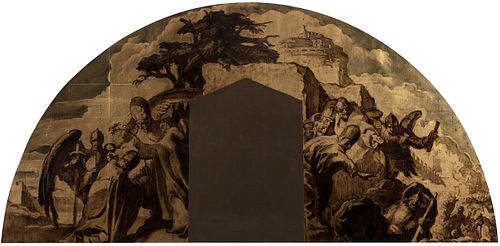JOSÉ MARÃA SERT (Barcelona, 1874 - 1945) "Seventh Beatitude" Sketch for the nave of the epistle in the cathedral of Vic, 1925-1927. Oil on canvas
Lot 74
About Seller
Setdart Auction House
Carrer Aragó 346
Barcelona
Spain
Setdart Subastas was born in 2004 and is currently the first online art auction in Spain with solidity, prestige and reliability guaranteed by our more than 60,000 users. Setdart has a young, dynamic and enterprising team ready to successfully manage the purchase and sale of art works through custom...Read more
Estimate:
EUR€16,000 - EUR€18,000
$16,842.11 - $18,947.37
Absentee vs Live bid
Two ways to bid:
- Leave a max absentee bid and the platform will bid on your behalf up to your maximum bid during the live auction.
- Bid live during the auction and your bids will be submitted real-time to the auctioneer.
Bid Increments
| Price | Bid Increment |
|---|---|
| EUR€0 | EUR€10 |
| EUR€200 | EUR€25 |
| EUR€500 | EUR€50 |
| EUR€1,000 | EUR€100 |
| EUR€3,000 | EUR€200 |
| EUR€5,000 | EUR€500 |
| EUR€10,000 | EUR€1,000 |
| EUR€20,000 | EUR€2,000 |
| EUR€50,000 | EUR€5,000 |
About Auction
By Setdart Auction House
Nov 10, 2021
Set Reminder
2021-11-10 08:00:00
2021-11-10 08:00:00
America/New_York
Bidsquare
Bidsquare : 19th & 20th Century paintings and Decorative Arts
https://www.bidsquare.com/auctions/setdart-auction-house/19th-20th-century-paintings-and-decorative-arts-7800
Setdart Auction House sofia@setdart.com
Setdart Auction House sofia@setdart.com
- Lot Description
JOSÉ MARÃA SERT (Barcelona, 1874 - 1945) "Seventh Beatitude" Sketch for the nave of the epistle in the cathedral of Vic, 1925-1927. Oil on canvas in the form of a lunette. Relined. Work referenced in; ALBERTO DEL CASTILLO, "José MarÃa Sert, his life and work". Barcelona - Buenos Aires. 1947. Lam.106. Measurements: 120 x 242 (frame: 132 x 254). This work of hemispherical format is the model of presentation for one of the mural paintings of the cathedral of Vic belonging to the lateral lunettes of the nave of the Epistle. The central opening of the sketch corresponds to the architectural niche of the wall. The piece called VII Beatitude alludes to the words of the Gospel according to St. Matthew (Matthew V): "Blessed are the peacemakers, for they shall be called sons of God". Dominating the center of the scene, in the upper zone of the lunette, the imposing presence of the castle of St. Angelo can be recognized. On the right side of the scene, flanking the lunette, we can see the figure of St. Leo facing Attila, located in the lower part of the image. The king of the Huns is accompanied by his army, which has been structured by the artist, creating a great depth in the scene. Regarding the left side of the composition, Sert portrays the Saint, receiving the olive branch from the hand of St. Michael the Archangel, St. Paul and St. Peter, sheltered under a large tree, next to which you can see a little sweetheart. The original painting of the cathedral was destroyed during the Civil War, therefore, so this sketch is an important graphic document preserved from the painter and was later used for the reconstruction of the mural. Although this work was commissioned in 1900, Sert did not present the first sketches until six years later, occupied by the numerous orders he received from the aristocrats of the time. The First World War interrupted the work and once it was resumed, Sert felt he had to modify the approach, eliminating color and, therefore, rethinking the perspectives to obtain depth. It was completed in 1929, but only seven years later it was destroyed. Shocked, Sert accepted the restoration of the cathedral, basing it this time on a set of bas-reliefs that he would not complete until the year of his death.José MarÃa Sert was one of the most sought-after and controversial painters of his time and one of the best Spanish muralists. Heir to the Catalan Renaixença and modernist training, he developed a pictorial style outside the stylistic currents of his time. These characteristics make him a renovator of mural painting and a prolific artist who painted more than seven thousand square meters of cathedrals, palaces, great halls, private residences and city halls of various cities, but undoubtedly the work that was most present throughout his life was the decoration of the Cathedral of Vic. Trained with Benito Mercadé and Pere Borrell, Sert was a member of the CÃrculo ArtÃstico de Sant Lluc, and later a disciple of A. de Riquer. In 1900 Torras i Bages commissioned a large mural decoration for the cathedral of Vic, of which he presented sketches and preparatory canvases in 1905 and 1907 in Barcelona and Paris, of which this piece is an example. Through his exhibitions abroad, he soon acquired extraordinary prestige among the French and English aristocracy, for whom he created sumptuous decorations. In 1908 he decorated the Sala de los Pasos Perdidos of the Palace of Justice in Barcelona, and in 1910 he presented at the Salon d'Automne in Paris the mural decoration of the ballroom of the Marquis of Alella (Barcelona) and decorated the music room of the Princess of Polignac in Paris. Two years later he exhibited an important group of works at the Salon in the French capital. In the following years he worked for Queen Victoria Eugenia (Santander) and for Robert Rotschild (Chantilly).
- Shipping Info
-
In-house shipping available. Please inquire at admin@setdart.com.
-
- Buyer's Premium



 EUR
EUR CAD
CAD AUD
AUD GBP
GBP MXN
MXN HKD
HKD CNY
CNY MYR
MYR SEK
SEK SGD
SGD CHF
CHF THB
THB















